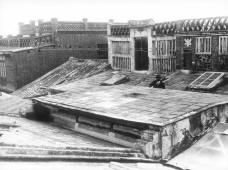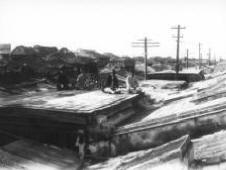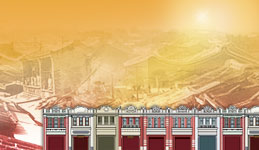          

|
|

|
 The Second Largest City
The Second Largest City
The “no sky” market area was the second largest city at that time.
The population of Lukang was
40,000 to 60,000 so lots of people
made their living on the street. Nevertheless, we can do some simple
categorization according to the resource of population and their
activities. What’s more special is that not all the people on Wufu
Street settled there and they didn’t have close relationship with
each other. This was very different from other regions, in which
people had ties of blood or came from the similar places. The
following is a brief introduction of the population resource and
financial ability of residences in Wufu Street.
|
|
 |
|
Route of Early immigrants
|
|
|
 TOP
TOP |
|
 Category
of Resource of People Category
of Resource of People
Early immigrants of Lukang can be divided into two
categories according to the population resource: one is the
Hans and another is aborigines. The Hans mainly crossed the
sea to Taiwan to reclaim wasteland because it was not easy
to earn their living along the Min and Yue. One small part
of them came to Taiwan because of the war during the later
years of Ming dynasty and early years of Cing dynasty. They
came to Taiwan to be away from the war or to do business.
More of the Han immigrants came for the former reason than
the later and we can see that the later type wasn’t of high
percentage. Nevertheless, The Han business people mainly
lived in
Wufu Street and become the major resource of
people. This category of people came mainly for business and
didn’t live in Wufu Street for long. This had influenced the
development of the street houses in Wufu street. (See street
houses in Cing dynasty.) In addition to the Hans, Pingpu
tribe, who had long lived in Lukang, might have been
assimilated by the Hans and were active in Wufu Street. The
categorization based on the resource of people is Figure I.
 TOP
TOP |
|
Resource |
Races |
Ratio |
Life |
|
Mainland |
Hans |
Most |
Farming |
|
Mainland |
Hans |
Few |
Commerce |
|
Local |
Pingpu |
Very
few |
Farming |
Figure I: Categorization Figure of Residences in Wufu Street.
|
|
|
|
 Categories of Financial Power
Categories of Financial Power
Wufu Street at that time was the major commercial center of
Lukang and all kinds of people were active there, including
lots of floating population such as the garrison after the
harbor was set, sailors of commercial ships, businessmen who
came to do business, and vagrants, so the street was filled
with people of various social status, from high to low, and
was very chaotic. In addition to the floating population,
some Lukang residences spent most of their time in Wufu
street. This sort of residences can be divided into
merchant and others. The commerce in Lukang was very
prosperous. The rich businessmen were very rich and had lots
of servants, labors, and long-term labors. In addition to
those who were hired by rich business men, there were other
kinds of people such as handy men, coolies (not hired), and
farmers. Compared with the rich businessmen, these people
lived in very simple and crude places and led poor lives.
There were also lots of so called “inferior people” working
in places taking care of rich businessmen’s needs, such as
cat houses, tea houses and geisha houses. They also had to
deal with groups of beggars. These so called “inferior
people” out numbered businessmen by a large percentage and
indicated the uneven distribution of wealth. The
categorization is demonstrated in Figure II.
 TOP
TOP |
|
Identity |
Financial Power |
Ratio |
|
Merchant |
Good |
Few |
|
Others |
Bad |
Most |
Figure II: Categorization Figure of Residences in Wufu
Street (according to financial ability)
|
|
There
were all kinds of people active in Wufu Streets. This
influenced the social order in Lugang. There were several
riots and some fights with weapons. Furthermore, non-local
people, especially so-called “Luohanjiao” (single men), had
disturbed the social order very much. The situation led the
residences of Wufu Street to the conclusion that the social
disorder was very serious and the power of the government
was too weak and thus they set up some organizations such as
“8-Jiaos” (see commercial organization). Meanwhile,
businessmen in Wufu Street established block gates to
protect their own lives and properties. All these measures
had something to do with the complexity of the social
components. |
|
 |
 |
|
People in the
street roof |
People in the top
of the street |
|
|
《Next
Transportation…》 |
|
|



